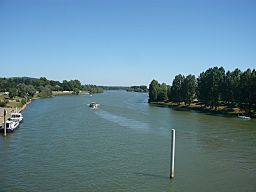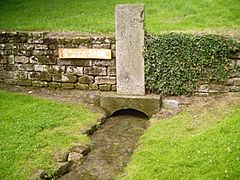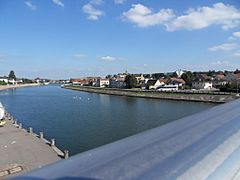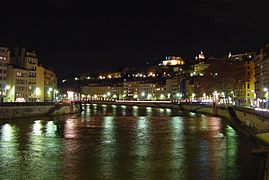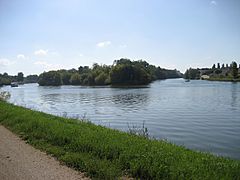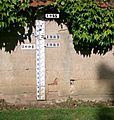Saône facts for kids
Quick facts for kids Saône |
|
| River | |
|
The Saône in Tournus.
|
|
| Country | |
|---|---|
| Regions | Grand Est, Bourgogne-Franche-Comté, Auvergne-Rhône-Alpes |
| Departments | Vosges, Haute-Saône, Côte-d'Or, Saône-et-Loire, Ain, Rhône, Metropolitan Lyon |
| Tributaries | |
| - left | Doubs, Lanterne, Ognon |
| - right | Vingeanne, Grosne, Azergues |
| Cities | Chalon-sur-Saône, Tournus, Mâcon, Villefranche-sur-Saône, Lyon |
| Source | |
| - location | Vioménil, Vosges, France |
| - elevation | 405 m (1,329 ft) |
| - coordinates | 48°5′32″N 5°10′47″E / 48.09222°N 5.17972°E |
| Confluence | Rhône |
| - location | Lyon, Metropolitan Lyon, France |
| - elevation | 161.8 m (531 ft) |
| - coordinates | 45°43′42″N 4°49′7″E / 45.72833°N 4.81861°E |
| Length | 480 km (298 mi) |
| Basin | 29,950 km² (11,564 sq mi) |
| Discharge | for Couzon-au-Mont-d'Or |
| - average | 470 m³/s (16,598 cu ft/s) |
The Saône is an important river in eastern France. It flows into the Rhône river, joining it from the right side. The Saône begins in the Vosges area and meets the Rhône in the big city of Lyon.
Two French areas, called departments, are named after this river: Haute-Saône and Saône-et-Loire. Both of these departments are located in the Bourgogne-Franche-Comté region.
Contents
Geography of the Saône River
The Saône river is about 480 km (298.3 mi) long. The area of land that drains into the Saône, called its drainage basin, covers about 29,950 km2 (11,564 sq mi).
Water Flow and Discharge
The amount of water flowing in the Saône river changes throughout the year. This flow is called its discharge. On average, about 470 m3/s (17,000 cu ft/s) of water passes through a section of the river near Couzon-au-Mont-d'Or in the Metropolitan Lyon area every second.
The river's water flow is highest in the winter months, especially in February. It is lowest during the summer, particularly in August. This pattern is common for rivers in this region, as they get more rain and snowmelt in winter.
Where the Saône River Flows
The Saône river starts in a place called Vioménil in the Vosges department. Here, it is about 405 m (1,329 ft) above sea level. From its source, the river generally flows towards the south-southwest.
The Saône travels through three main regions and six different departments in France. Here are some of the towns and cities it passes through:
- Grand Est region:
- Vosges department: Darney, Monthureux-sur-Saône, Châtillon-sur-Saône.
- Bourgogne-Franche-Comté region:
- Haute-Saône: Jonvelle, Corre, Jussey, Port-sur-Saône, Scey-sur-Saône, Gray;
- Côte-d'Or: Auxonne, Saint-Jean-de-Losne, Seurre;
- Saône-et-Loire: Verdun-sur-le-Doubs, Chalon-sur-Saône, Tournus, Mâcon, Crêches-sur-Saône.
- Auvergne-Rhône-Alpes region:
- Ain: Thoissey, Jassans-Riottier, Trévoux;
- Rhône: Belleville-sur-Saône, Villefranche-sur-Saône, Anse;
- Metropolitan Lyon: Neuville-sur-Saône, Fontaines-sur-Saône, Caluire-et-Cuire, Lyon, La Mulatière.
Finally, the Saône river flows into the Rhône river in the city of Lyon. This is where the two rivers meet, which is called a confluence.
Main Rivers Joining the Saône
Many smaller rivers flow into the Saône. These are called tributaries. Here are some of the most important ones that are longer than 40 km:
|
Rivers Joining from the Left:
|
Rivers Joining from the Right:
|
Gallery
-
The source of the Saône in Vioménil.
-
The Saône in Gray.
-
View over the Saône, Lyon.
-
The Saône river in Lyon by night.
-
Confluence of Saône and Doubs rivers.
Related pages
Images for kids
-
Scenic view of the banks of the Saône in Lyon, showing Lyon Cathedral, the Basilica of Notre-Dame de Fourvière, and the Tour métallique de Fourvière
-
Historic floods since 1950 in Écuelles, northern Saône-et-Loire
See also
 In Spanish: Río Saona para niños
In Spanish: Río Saona para niños


